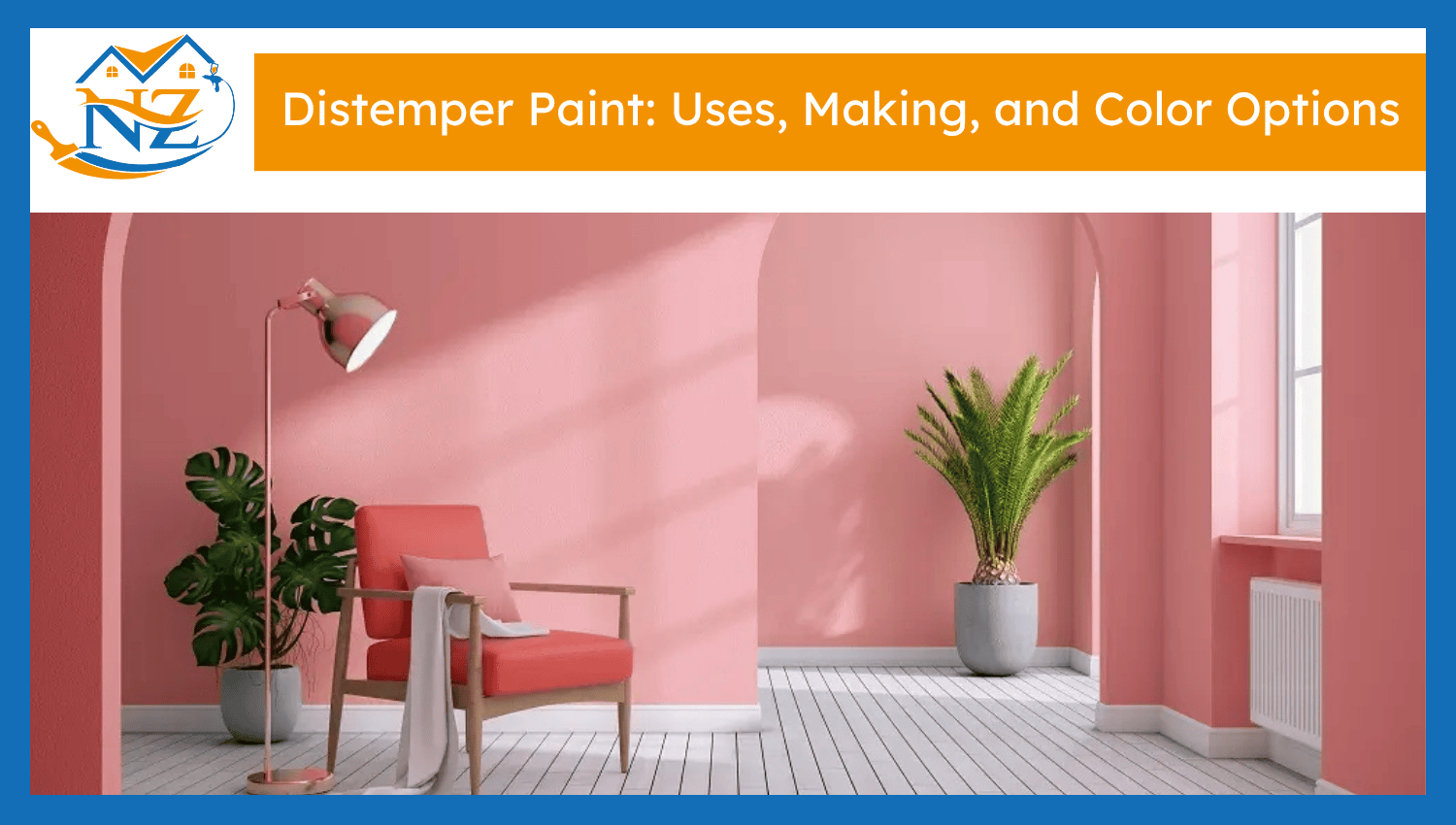

Distemper paint is a type of water-based paint. It is made from chalk or lime, pigment, and natural glue-like starch or animal glue. Distemper paint has been used for centuries on interior walls. It gives a matte texture and works best in dry indoor environments. It is environmentally friendly and simple to use, but it is not water resistant. It can fade away in wet areas. It is applied in some projects as a base coat, like on plaster or masonry, where it is not primed. It is typically used on indoor walls and ceilings, but it can also be used outdoors. Distemper is a good choice for temporary finishes or low-cost projects. It helps in enhancing the sticking of top coats.
Here are the key properties of distemper paint.
| Property | Description |
|---|---|
| Type | Water-based decorative paint |
| Finish | Matte, powdery finish |
| Application Areas | Interior walls and ceilings (not suitable for high-moisture areas) |
| Durability | Low to moderate (less durable than emulsion or enamel) |
| Drying Time | 2–4 hours (touch dry), 24 hours (fully dry) |
| Coverage | 8–10 m²/litre per coat (varies with surface texture) |
| Cost | Low; very economical |
| VOC Content | Low |
| Application Methods | Brush, roller, or spray |
| Availability | Available in ready-mix or powder form |
| Color Options | Limited compared to modern emulsion paints |
| Shelf Life | 12–18 months for ready-mix (in sealed containers) |
Here are the 4 main types of distemper paint:
Acrylic-based distemper paint offers a modern alternative to lime-based paint. It produces a brighter and smoother finish. It dries quickly and is suitable for schools, offices, and homes. Acrylic-based distemper paint is ideal for areas that need renovation quickly.
Oil-bound distemper is semi-washable and slightly more water-resistant because it includes oil-based binders. It provides a smooth, rich finish and sticks well on plastered surfaces. It works best in damp areas such as kitchens or bathrooms. It stays longer in moist weather than basic distemper paints.
Casein Distemper has a very flat matte finish and is highly breathable; it’s excellent for plaster walls and ceilings. It is eco-friendly and is often used in older buildings, museums, or heritage interiors. It provides a natural look but isn’t washable.
Dry distemper is a powdery form of distemper combined with water. Dry distemper is the least durable and not washable. It is ideal as a temporary coating or an inexpensive indoor application. Dry distemper is ideal for ceilings and low-traffic walls.
Pour 1 liter of water into a clean bucket and then add 500g of whiting powder to it. Mix until smooth. Add 50g animal or plant glue. Mix up again to get rid of any lumps. Add a 20g color powder and mix it in. Filter the mixture with a fabric or fine strainer. Leave the paint thick, creamy consistency. Apply it with a brush or roller on clean and dry walls. It gives a matte and softer appearance. Avoid applying it to wet walls. Keep any extra paint in a closed box in a cool and dry place.
Here are the 2 basic steps for applying distemper paint:
Scrub the surface clean to remove dust, grease, or loose paint. Fix cracks and make smoother surfaces. Apply a primer coat for refreshed or absorbent walls to ensure better sticking of distemper paint.
Combine water and mix distemper in a 1:1 ratio. Apply with a brush, a roller, or by spraying. Use 2 or 3 coats of complete coverage. Give 4-6 hours of drying time between the coats.
Here are the 2 main color choices to select the right color:
Common distemper colors include off-white, cream, beige, light blue, soft pink, and pale yellow. These neutral colors provide a clean and simple look.
| Color Name | Color Tone | Typical Use |
|---|---|---|
| Classic White | Neutral | Ceilings, small spaces, clean look |
| Soft Peach | Warm Pastel | Bedrooms, dining areas, romantic ambiance |
| Light Grey | Cool Neutral | Modern interiors, minimalistic rooms |
| Sky Blue | Cool Pastel | Kids’ rooms, ceilings, calming effect |
| Terracotta | Warm Earthy | Traditional settings, rustic appeal |
| Rose Pink | Soft Warm | Kids’ rooms, feminine spaces |
| Sand Beige | Neutral Earthy | Living spaces, corridors, classic and elegant |
The majority of brands can assist you in the selection by providing a color chart. Select colors depending on the wall texture, size, and lighting of the room. According to the Journal of Environmental Psychology (2022), light colors are used to give small spaces a spacious and light effect.
| Room Type | Lighting | Recommended Shades |
|---|---|---|
| Living Room | Natural or mixed | Ivory Cream, Sand Beige, Light Grey |
| Kids’ Room | Natural/daylight | Sky Blue, Lemon Yellow, Rose Pink |
| Kitchen | Bright/artificial | Lemon Yellow, Ivory, Light Grey |
| Bathroom (dry wall) | Artificial only | White, Sky Blue |
Yes, you can paint emulsion over distemper, but first apply an oil-based primer on the surface. The direct application causes poor sticking and peeling. The emulsion also stays longer when the surface is properly prepared.
Scrape off or brush away the loose paint with a scraper or a stiff brush. Clean the surface using soapy water. When the distemper is thick, wet the wall so that it becomes soft and scrape it off.
No, distemper paints are not toxic. When sanding the surface, always use a mask to prevent inhaling the dried distemper.
The average lifespan of distemper paint is 3 to 5 years. It depends on the surface material, care, humidity, and sun exposure. High-traffic or moist areas require repainting earlier.